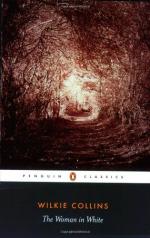The next inquiries related to the fire.
The servant and I, and the boy who had heard the light struck in the vestry, were the first witnesses called. The boy gave his evidence clearly enough, but the servant’s mind had not yet recovered the shock inflicted on it—he was plainly incapable of assisting the objects of the inquiry, and he was desired to stand down.
To my own relief, my examination was not a long one. I had not known the deceased—I had never seen him—I was not aware of his presence at Old Welmingham—and I had not been in the vestry at the finding of the body. All I could prove was that I had stopped at the clerk’s cottage to ask my way—that I had heard from him of the loss of the keys—that I had accompanied him to the church to render what help I could—that I had seen the fire—that I had heard some person unknown, inside the vestry, trying vainly to unlock the door—and that I had done what I could, from motives of humanity, to save the man. Other witnesses, who had been acquainted with the deceased, were asked if they could explain the mystery of his presumed abstraction of the keys, and his presence in the burning room. But the coroner seemed to take it for granted, naturally enough, that I, as a total stranger in the neighbourhood, and a total stranger to Sir Percival Glyde, could not be in a position to offer any evidence on these two points.
The course that I was myself bound to take, when my formal examination had closed, seemed clear to me. I did not feel called on to volunteer any statement of my own private convictions, in the first place, because my doing so could serve no practical purpose, now that all proof in support of any surmises of mine was burnt with the burnt register; in the second place, because I could not have intelligibly stated my opinion—my unsupported opinion—without disclosing the whole story of the conspiracy, and producing beyond a doubt the same unsatisfactory effect an the mind of the coroner and the jury, which I had already produced on the mind of Mr. Kyrle.
In these pages, however, and after the time that has now elapsed, no such cautions and restraints as are here described need fetter the free expression of my opinion. I will state briefly, before my pen occupies itself with other events, how my own convictions lead me to account for the abstraction of the keys, for the outbreak of the fire, and for the death of the man.




